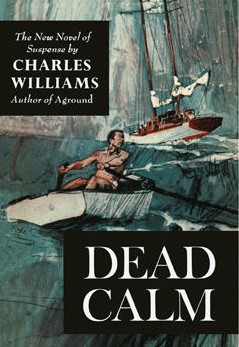 By CHARLES WILLIAMS (Viking; 1963)
By CHARLES WILLIAMS (Viking; 1963)
The most famous novel by the legendary pulp fiction maestro Charles Williams (1909-75), a horrific suspense thriller par excellence. Few authors could match Williams when he was at his most inspired, and DEAD CALM was such an occasion. Many deem it his finest work.
DEAD CALM was inspired by the Bluebelle case of 1961, consisting of a series of killings that occurred aboard a sailing ketch on the open sea. The case inspired another famous novel, John D. MacDonald’s highly regarded 1967 thriller THE LAST ONE LEFT, while DEAD CALM served as the inspiration for the 1989 movie of the same name starring Nicole Kidman and Sam Neill (and also an earlier, unfinished film project by Orson Welles).
The novel was also a sequel to 1960’s AGROUND, which introduced the steely Captain John Ingram and his widowed girlfriend Rae, who’s now Mrs. Rae Ingram. Both novels belong to Charles Williams’ “blue-water noir” period (which followed his “backwoods noir” books), consisting of a handful of thrillers that showed off his considerable knowledge of all things nautical. Some of those novels are difficult to read for readers unfamiliar with nautical terminology (such as AGROUND), but in DEAD CALM the emphasis is precisely where it should be: on the storytelling and the characterizations.
The set-up is quite simple: Ingram and Rae are honeymooning on a yacht in the Pacific. All seems idyllic, and not a little boring, until they happen upon a sinking ship—and a desperate passenger fleeing that ship. That passenger is Warriner, who claims to be the only survivor of the sunken boat’s four-person crew.
The stage would seem to be set for a three-person claustrophobia-fest a la Roman Polanski’s KNIFE IN THE WATER (as was the case with the movie version), but the narrative takes a sharp turn around a third of the way in. It’s here that Ingram, suspicious of Warriner’s account, decides to investigate the sinking ship. Onboard he discovers a man and a woman who tell stories of what went down aboard their ship that are radically different from Warriner’s. He’s a homicidal psychopath, it seems, and takes off in Ingram’s boat with Rae, leaving Ingram to fend for himself aboard the sinking ship.
There’s far more to this story, which works primarily due to the consistently gripping and unpredictable interplay between its four protagonists. It’s no exaggeration to say that DEAD CALM contains some of the most complex and well-rounded characters in the entire noir fiction cannon. Equally praise-worthy is the prose, which strikes a nice balance between hard-boiled terseness and conversational ease, and also the genuinely startling, hard-hitting violence of the climax.
The novel may ultimately be a bit too long given the minimal nature of its story (included is a lengthy summary of AGROUND’S plot, which can be skipped), but as the classy pulp suspensor it is, DEAD CALM more than satisfies.
